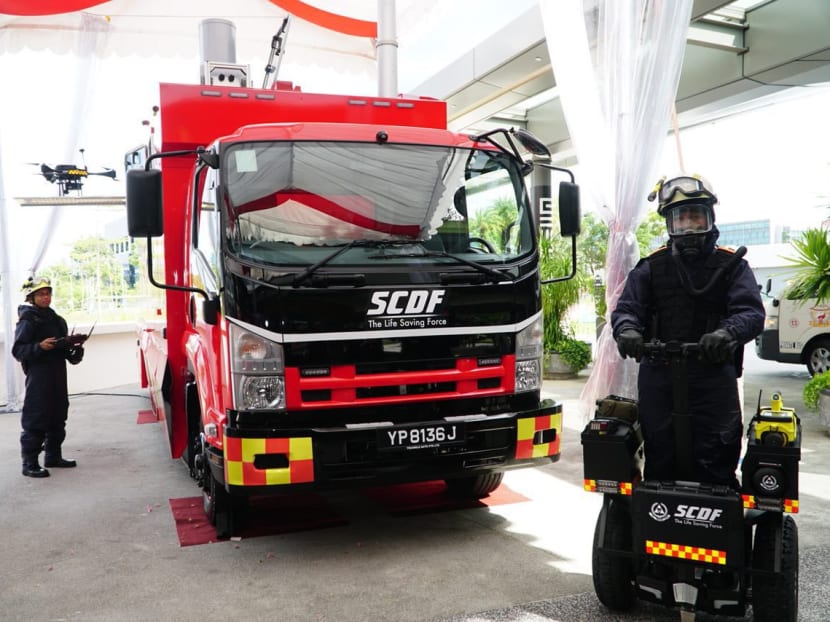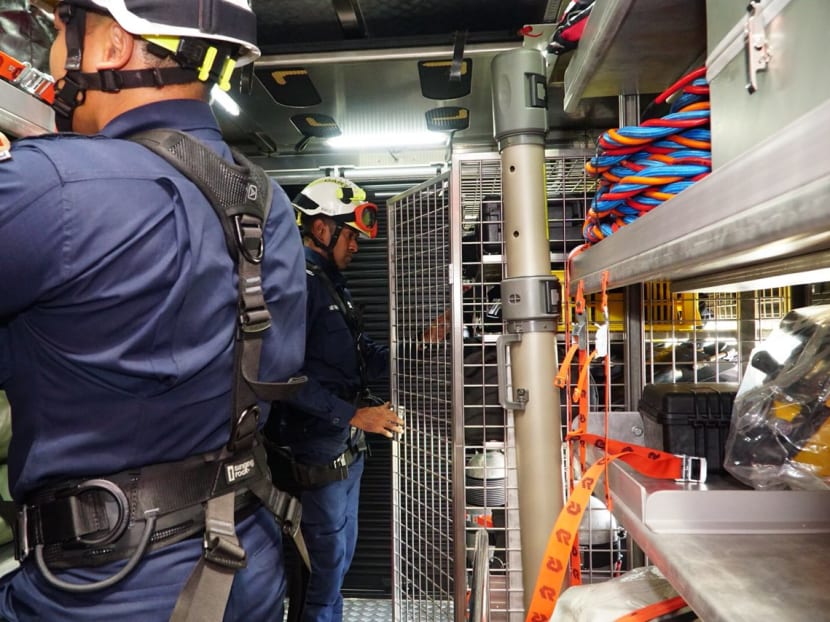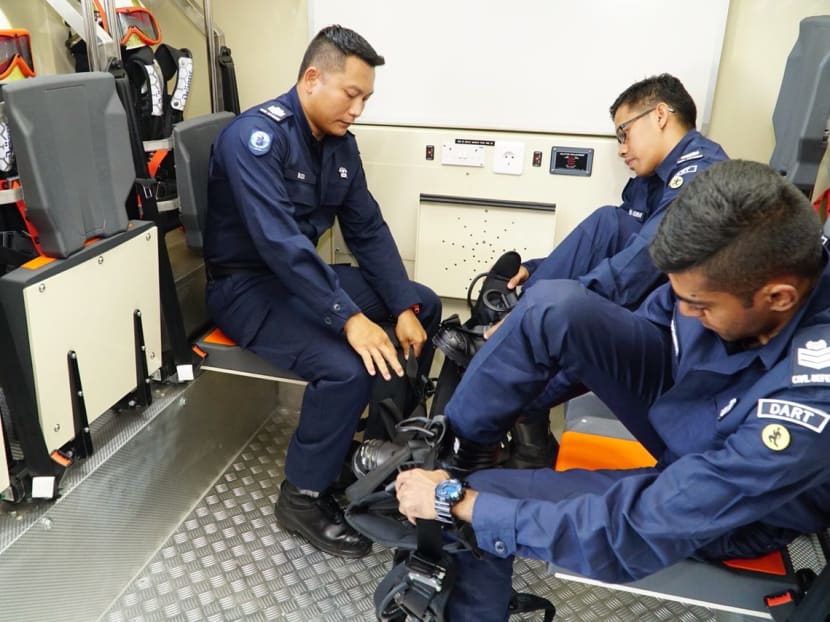SCDF unveils 2 new vehicles to boost response to chemical leaks, rescue missions
SINGAPORE — Detecting and monitoring hazardous materials from a distance is now possible, with the Singapore Civil Defence Force’s (SCDF) second-generation Hazardous Material (HazMat) vehicle.

The second-generation HazMat vehicle is fitted with a launchpad, allowing officers to launch drones attached with chemical detectors from the vehicle. The drone capabilities will allow officers to measure not only the geographical spread of contamination, but also the height of the spread. Photo: SCDF
SINGAPORE — Detecting and monitoring hazardous materials from a distance is now possible, with the Singapore Civil Defence Force’s (SCDF) second-generation Hazardous Material (HazMat) vehicle.
Unveiling two new next generation applications at their annual workplan seminar on Wednesday (April 18), SCDF Commissioner Eric Yap said the vehicles have been “thoughtfully-designed to enable our emergency response specialists to perform their tasks better”.
For example, the small cylindrical chemical detector placed atop the new HazMat vehicle, will allow the HazMat Emergency Assessment and Response Team (HEART) to detect and monitor chemical release from up to 5km away.
Previously, all chemical detections had to be done at “point source”, meaning the detector “must come into contact with the chemical before being identified”, explained senior assistant director of SCDF’s HazMat Department Ryan Ong.
Lieutenant-Colonel (LTC) Ong added this new feature will allow the team to identify chemical hazards more efficiently, while ensuring their safety.
In addition, the new vehicle, which can accommodate up to three HEART officers, is also fitted with a launchpad for drones.
Officers can use it to deploy drones, attached with chemical detectors weighing up to 5kg. With a flight time of up to 20 minutes, the drones will enable the officers to measure not only the geographical spread of contamination over a long distance, but also the height of the spread.
Currently, the point-source detectors allow officers only to measure the chemical spread on the ground. “But if we deploy the drone … we can know (for example), up to which level certain buildings are being affected,” said LTC Ong.
Given that toxic plumes can quickly spread across a wide area, early detection of the plume movement is crucial for effective mitigation of the incident, said the SCDF.
The SCDF declined to reveal the frequency of HazMat incidences in Singapore. The most recent reported incident involved an the ammonia leak at a Jurong food factory in January this year, which saw four people taken to hospital.
With another enhanced vehicle expected to join the fleet by the end of the year, the HEART team will have three vehicles in its fleet. The last time the HazMat vehicle was upgraded was in 2015.
Another SCDF vehicle, the Disaster Assistance and Rescue Team (DART) rescue vehicle, was also enhanced to allow DART officers to respond more efficiently to rescue incidents on land, high buildings and in water.

The upgraded Disaster Assistance and Rescue Team (DART) rescue vehicle will allow DART officers to respond to height, land and water rescue incidents. Photo: SCDF
For one, the new DART Rescue Vehicle (DRV) — almost 10m in length and weighing 9.5 tonnes — now has more room in the personnel cabin to allow DART officers to change into various protective equipment en route to the incidents. Previously, sitting knee-to-knee in the vehicle, officers could suit up only upon reaching the scene.

The upgraded Disaster Assistance and Rescue Team (DART) rescue vehicle will have more room for DART officers to change into their gear while en route to the site of the incident. Photo: SCDF
The personnel cabin has also been equipped with a mini projector, allowing DART commanders to conduct operational briefings while on the move.
“Commanders can use google maps (to locate the scene of the incident) and beam it onto the projector, and their guys will be able to know the kind of terrain they will deployed to ... and get real-time updates,” said DART Platoon Commander Kelvin Koh.
The upgraded DRV, which can accommodate up to eight DART officers, is also fitted with side compartments to store equipment which are frequently used, such as ropes, hydraulic rescue tools and rescue nets.
The equipment that is heavier and less frequently used like diving tanks will be stored in modular compartments.
Lastly, the DRV also has a crane which is able to take up to 7.9 tonnes in weight, compared to 6 tonnes previously. It is primarily used to load other rescue vehicles like the DART skid loader, which is used to access confined spaces in collapsed buildings, for example.
The SCDF plans to have three DRVs by the end of this year, located at the SCDF Headquarters in Ubi.
Said Captain Koh: “The enhancements on the DRV will reduce the time officers take to start work, allowing officers to start work upon arrival, instead of reaching the location and (only then) start preparing to start work.”






